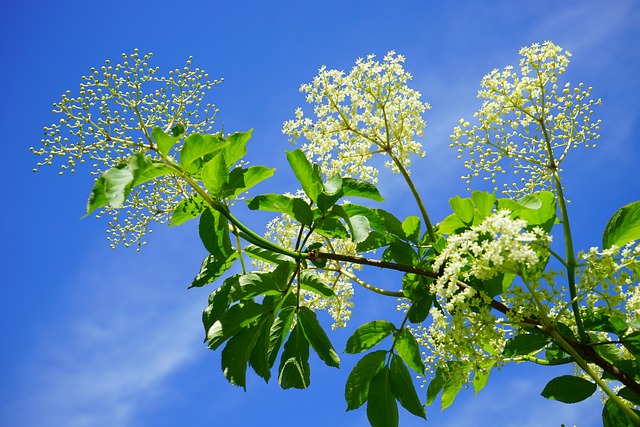A field guide on how to identify and propagate European Elderberry (Sambucus nigra), a hardy shrub that is native to Europe.
European Elderberry Traits
Leaves
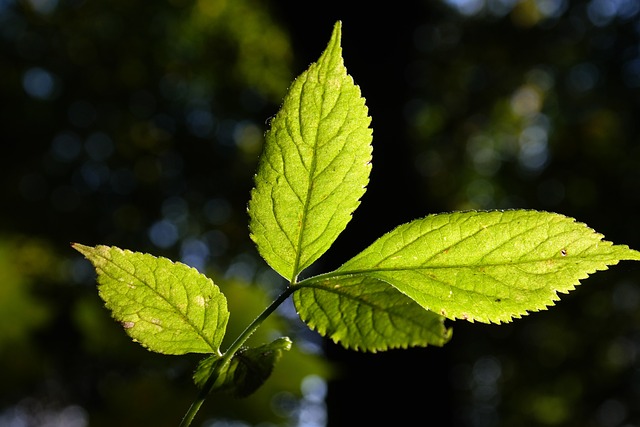
European elderberry leaves are elliptical to lance-shaped, have serrate margins, and grow on the leaves in opposite arrangements.
Fruit
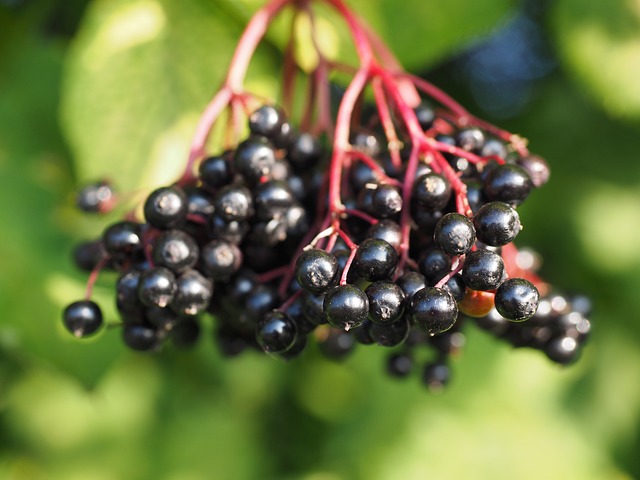
The fruit is small, dark purple, and round, and grows in clusters. It is roughly 1/4 to 1/2 inch in diameter and has a juicy, slightly tart flavor.
Flower
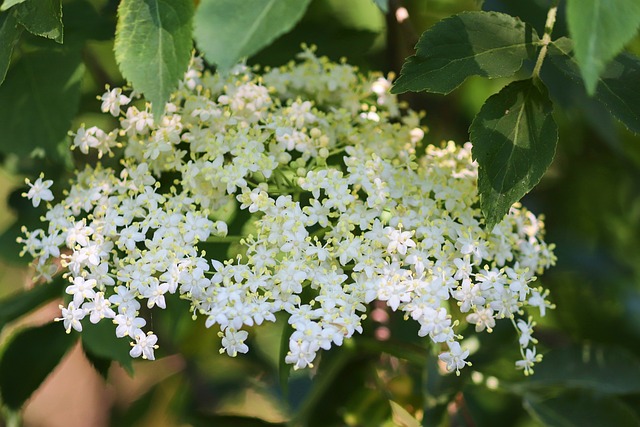
The European elderberry (Sambucus nigra) produces clusters of creamy-white, fragrant flowers in the spring.
The flowers are small and star-shaped, with five petals and a prominent yellow center.
They are commonly used in herbal teas and elderflower cordial, and are known for their delicate floral aroma and sweet, slightly musky flavor.
Flowering Season
Elderberry flowers typically bloom from early to mid-summer. Fruits follow and ripen by late summer to early fall.
Habitat
Elderberry is a pioneer plant, it thrives in areas of forest that have been disrupted, such as along roads, in areas of land degradation, fence rows, disturbed sites, and on land previously used for settlements.
Some other understory plants that associate with European elderberry are:
- Stinging Nettle (Urtica dioica)
- Cow Parsley (Anthriscus sylvestris)
- Hogweed (Heracleum maximum )
- Meadowsweet (Filipendula ulmaria)
- Common Yarrow (Achillea millefolium)
Wildlife Value
Elder flowers offer nectar to a range of insects, while berries serve as a food source for birds and mammals.
Both the flowers and berries are consumed by small mammals like bank voles and dormice.
The foliage of elderberry is also a food source for various moth caterpillars, such as the white-spotted pug, swallowtail, dot moth, and buff ermine.
How to Propagate European Elderberry (Sambucus nigra)

Hardiness Zone: 3-8

Soil Type: Well-drained chalk, clay, loam, sand.

Water: Normal.

Exposure: Full Sun to Partial Shade
You can propagate European elderberry with two effective methods:
- Stem Cuttings: It provides established trees faster, but is tricky, and will probably have a lower success rate.
- By Seed: The success rate is high but takes longer to get established saplings.
How to Propagate European Elderberry (Sambucus nigra) by Seed
You can harvest elderberry seeds yourself if you found some plants nearby. The best time to harvest elderberry seeds is late summer when the seeds have matured.
How to Harvest Seeds
There are two ways to harvest the seeds from the fruits.
- The first option involves cutting open the fruits and extracting the seeds with tweezers.
- The second option is to use a blender to blend the fruits, strain the mixture, remove the pulp, strain it again, and collect the small seeds.
After harvesting, it’s essential to let the seeds dry thoroughly to store them properly. For air drying, keep them in a cool, well-ventilated area away from direct sunlight.
Try to avoid storing the seeds for too long as they’ll lose their viability.
Alternatively, you can store the fruits, with the seeds inside in the freezer for cold stratification.
Sowing
For outdoors: You should sow them in the fall this year and they’ll sprout the following spring.
Indoors, they’ll need cold stratification, here’s how to cold stratify elderberry:
Inside:
- Place seeds in a ziplock bag with dampened sand, then tag well with the name and date.
- Place in refrigerator for 60 days, then place them in room temperature water for 12 hours.
- Put back in ziplock in the refrigerator for another 30 days.
- After this period, plant under 1/4 inch potting soil, moisten and cover with plastic wrap to keep a good level of humidity.
How to Propagate European Elderberry (Sambucus nigra) by Cuttings
A great method to propagate elderberry is by taking hardwood cuttings. The best time to do that is late fall or early spring when the shrub is still dormant.
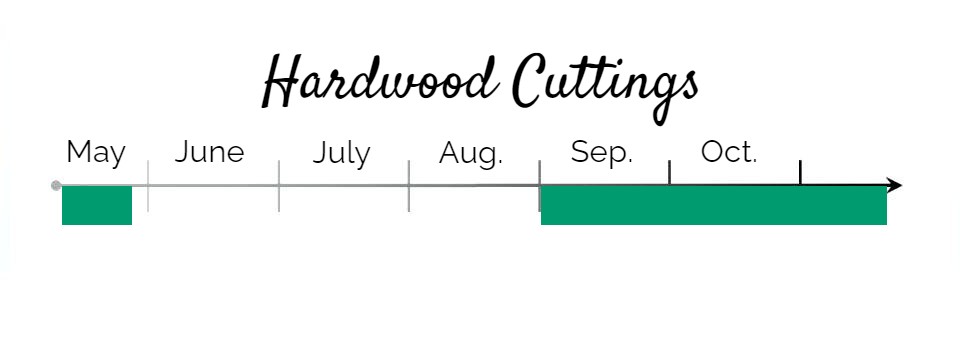
Very important: Choose a young, healthy plant to take cuttings from. Older shrubs are less vigorous and harder to root!
Step 1: Harvest the Cuttings
- First, find branches that have relatively new growth on them, at least from the previous year or two. Note: You can take a whole branch and make multiple cuttings from it.
- Snip the branch just below a node, and make sure the width of the cutting is not too thin, 1/4″ to 1/2″ width each is fine. Thick cuttings also work.
- Trim any forking branches from the main stem, then cut your branch into cuttings 6-8 inches long each. Each cutting can have multiple pairs of nodes, as long as the bottom cut is just below the node.
Step 2: Root the Cuttings
- Elderberry cuttings will easily root in any soil mix, but we recommend a well-drained, well-aerated mix like peat moss with perlite.
- Make sure the cuttings are the right way up and look closely at which way the leaf nodes are growing to make sure they’re not upside down.
- Place the cuttings in a spot with indirect sunlight, not shady but not right into bright sunlight.
- Keep the medium moist, but maintain proper ventilation to avoid rot.
- Elderberry hardwood cuttings start rooting within 3-4 weeks.
- Wait until at least 8 weeks of roots to transplant.
FAQ
A: Yes, you can, elderberries are similar to willows, they form roots vigorously in soil or even water.
A: It takes at least 8 weeks for elderberry cuttings to form strong roots, at this time you will be able to transplant them into the ground.
A: Yes, fall is a great time to harvest hardwood cuttings. Alternatively, you can harvest them very early spring while the plant is still dormant.
A: You can harvest the seeds yourself, cold-stratify them for 90 days, then sow under 1/4 inch soil.
A: Make sure the cutting is the right way up, and cover halfway into water. Transplant them quickly before the roots get too used to water.

